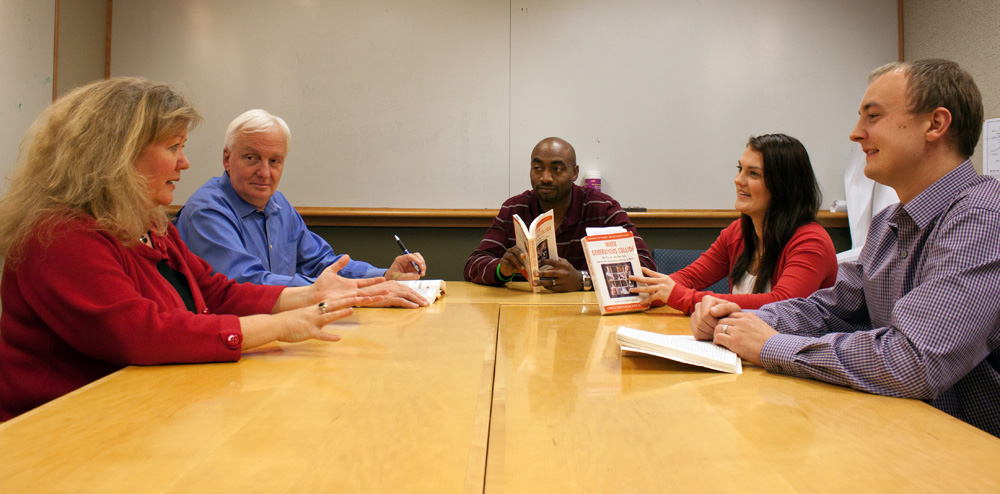We have a book study as a part of our regular operations and marketing meeting each week at Reid Middleton. We’ve gone through several beneficial books, including Good to Great, Built to Last, and the Living Company. The great part of studying a book as a group is not only the general discussion and further learning from a group atmosphere, but it raises questions about how our organization is operating (should we be changing?) and even generates discussions around the mission and core values of the organization. We’ve found it valuable to have these discussions on a regular, recurring basis rather than the typical annual discussion at a strategic planning retreat.
Most recently, we studied the book “When Generations Collide” by Lynn Lancaster and David Stillman. The book is focused on how the different generations think and act in the workplace and understanding each other better. The generations presented in the book aren’t defined only by their personal age, but by how life events in society create generations that fundamentally think and act differently than generations before or after them. It is based on studies conducted by, and the experiences of, the authors who have been running a generational differences consulting business for some time.
Generational studies have identified four distinct generational archetypes typical throughout American history. Each generational type lasts 20 – 30 years, and then the pattern repeats. Today’s primary workplace generations are known as the Boom Generation, the X Generation, and the Millennial Generation (also known as the Y Generation). The fourth type, Traditionalists, is now moving out of the workforce, but was a key component of workplace dynamics 10 years ago when this book was written. The role in society of each of these generations parallels similar relationships active in America 80 years previously.
Generations are highly influenced by societal trends during their formative years. For the Boom Generation, a generally competitive spirit emerged as they had to fight each other for space in overcrowded schools, colleges, and to get the best jobs.
The X Generation, characterized as the neglected children of the Boom Generation, became the latchkey kids, figuring out how to make do on their own, and being themselves, or having friends who were, the children of divorced parents, and growing up in a land-of-plenty with underutilized schools, expanding college opportunities, and jobs‑a‑plenty.
The Millennial Generation is growing up as the protected children of the X Generation, who returned to strong family values they didn’t see growing up, and has an unprecedented “connectivity” to each other through the emergence of the internet and cell phones.
“When Generations Collide” brings these theories to today’s work environment and discusses how we can all understand each other so we can get along better in the workplace.
For our study, we invited some of our own Gen X and Millennial staff to join our weekly meeting (which is generally populated by “older” X-ers and Boomers). We wanted to find out if the book’s assertions about the younger generations in the workplace rang true with our own experiences. The discussions were frank and honest.
One of the early points of the book is how the generations typically look differently at their careers and their relationship to the company. Boomers often think along the lines of “Build a Stellar Career,” with the goal of staying with the same company a long time. X-ers often think in terms of “Build a Portable Career.” Having seen too much down-sizing and being driven to depend on themselves, they are anticipating having to move to a different company either to survive or simply to move up. Millennials often think along the lines of “Build Parallel Careers,” working one job while having an afterhours interest in something different that might turn into an integrated career later on.
All of these perspectives are perfectly relevant and acceptable. The key is for each of us to realize the people we supervise, or who supervise us, can come from a different perspective and are inspired, rewarded, and interested in different elements of our work.
At the end, we all had a better feel for the other generations in the workplace. It even made us individually question our own definitions of success and what our own personal drivers really are. The book is an entertaining read. The benefit for our company was definitely in sharing the book’s observations among ourselves to see if they were valid and considering how well we are accommodating all of the generations.



To the team at Reid…
I love hearing not just that you read the book, but that you spent the time discussing it as a multigenerational team. Both Lynne and I had always hoped that would be the case. What is so fun about this topic is just what you said — people will be frank and open about it…that is the best way to get it on the table and talk through our differences. With committed folks like all of you, we will do our best to day up on the latest trends and and bring them to you. Please stay in touch with us – http://www.generations.com.
Lynne Lancaster & David Stillman
David,
Thanks so much for your interest in Reid Middleton and how we have used your book to work better as a team. Your insight, supported by independent study, helped us focus on the real issues in today’s workplace.
Bob Galteland, President
Reid Middleton, Inc.